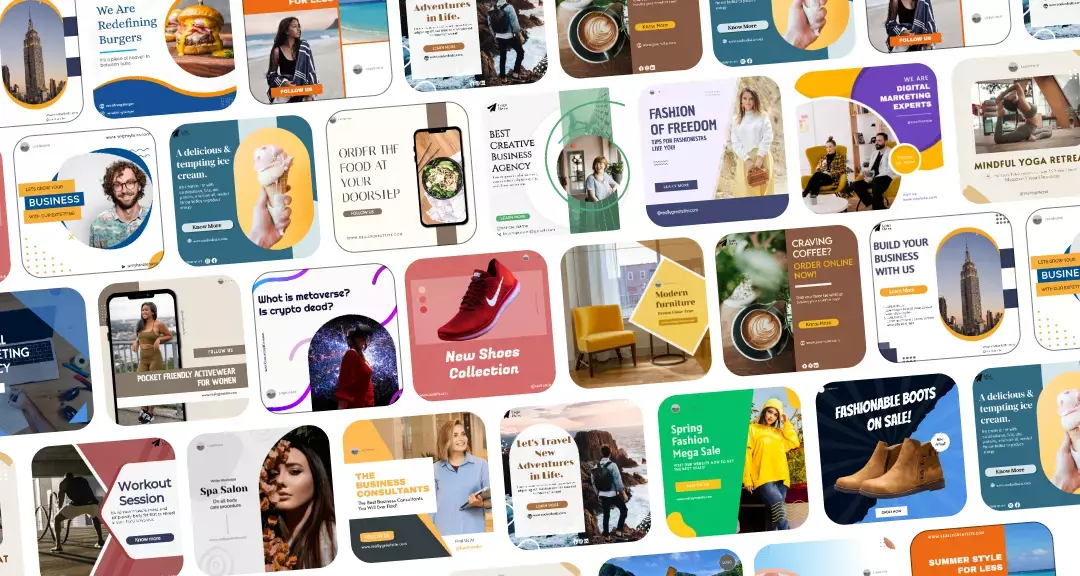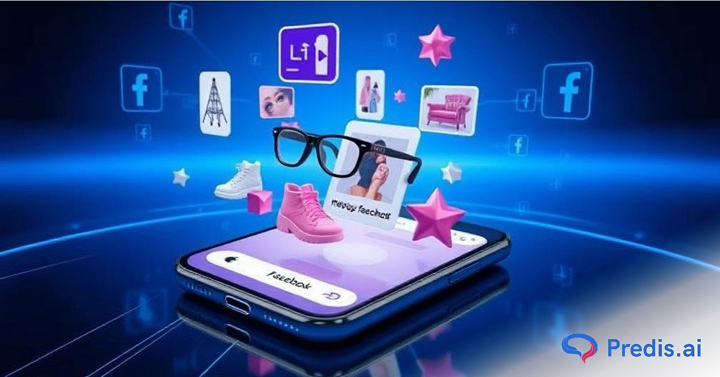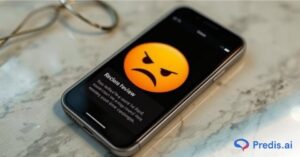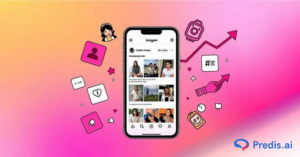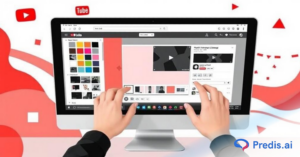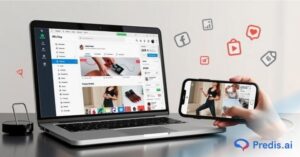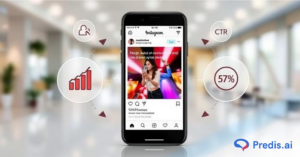Augmented reality (AR) ads are changing how companies talk to their customers. This is because it has so many users and interactive ad forms, Facebook has become one of the best places to show AR ads. People can really interact with brands through these ads. Whether it’s putting on sunglasses, makeup, or even a 3D car show. This blog post will look at 15 of the best Facebook Augmented Reality ads and talk about their effects, response rates, and why they worked.
What Are Facebook Augmented Reality Ads?
Facebook augmented reality (AR) ads combine interactive filters, 3D animations, and virtual try-ons to provide a compelling user experience. These ads display in Facebook’s News Feed, Instagram Stories, and Messenger. This allows the users to interact with products before purchasing.
Key Advantages of Augmented Reality (AR) Ads:
- AR ads are better than static ads as they generate 28% higher engagement.
- Higher conversion rates: Brands using AR ads saw a 40% boost in conversions.
- Improved customer experience: Reduces uncertainty by allowing users to virtually test things.
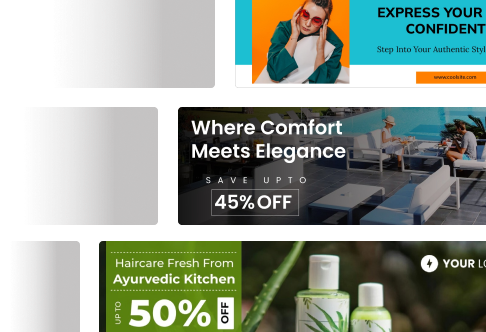
Facebook AR ads work so well because they’re interactive and let people try products virtually like sunglasses, makeup, or even furniture, right from their phones. These immersive ads not only boost engagement but also increase conversions by up to 40%, making them one of the most effective ad formats for brands today.
Top 15 Facebook AR Ads Examples
Michael Kors – Virtual Sunglasses Try-On
The augmented reality (AR) technology offered by Facebook was utilized by Michael Kors in order to develop an immersive shopping experience for eyewear enthusiasts. Before making a purchase, users were able to digitally put on a variety of sunglasses and see how they appeared during the actual wearing experience. This interactive element not only increased client confidence but also led to a 14% rise in ad recall and dramatically increased conversion rates. In addition, it led to an increase in user engagement.
Sephora – Try Before You Buy (Makeup AR)
By adding an augmented reality (AR)-powered “Try Before You Buy” option, Sephora transformed the process of purchasing makeup online. It was possible for customers to digitally try on a variety of lipstick tints, which eliminated the need for guesswork and improved their overall buying experience. Following the implementation of this innovation, there was a 7.9% increase in brand awareness as well as a discernible rise in online sales.

IKEA – AR Home Furniture Placement
With the help of its augmented reality-powered placement tool, IKEA revolutionized the way in which customers shop for furniture. Before making a purchase, customers were able to imagine how particular items, such as sofas, tables, or shelves, would fit into their living spaces. The seamless integration of augmented reality (AR) into the process of shopping for home decor resulted in 71% of consumers ranking the AR experience higher than the traditional techniques.
Ray-Ban – Interactive Glasses Try-On
With the introduction of a virtual glasses try-on experience, Ray-Ban has taken the process of purchasing eyewear to a whole new level. In order to make an informed purchase decision, customers were able to view how various frames complemented their face shape. Higher engagement rates and a 20% increase in conversions were achieved as a result of this interactive strategy.
NYX Cosmetics – Live Virtual Makeup Experience
An revolutionary augmented reality (AR) tool for applying makeup in real time was released by NYX Cosmetics. This tool made it possible for customers to rapidly test out a variety of cosmetic items. The power of augmented reality (AR) in the beauty sector was demonstrated by the fact that users did not stop interacting with this engaging experience for an average of 38 seconds per session.
Adidas – Interactive Sneaker Try-On
Through the use of an augmented reality (AR) function, Adidas made it possible for customers to visualize how various models would look while they were wearing them. This technology assisted in lowering the level of ambiguity, which meant that there were fewer returns and an increase in buyer trust.
Porsche – 3D Car Showcase with AR
An augmented reality (AR)-powered car showroom was created by Porsche, which enables prospective purchasers to examine the interiors and exteriors of automobiles using their mobile devices. The immersive experience resulted in a longer period of time spent engaging with the brand and better brand memory.
Pepsi Max – ‘Unbelievable’ Bus Shelter
When Pepsi Max transformed a mundane bus stop into a mind-blowing augmented reality experience, it was able to capture viewers. Surreal events, such as flying saucers and tigers roaming around, appeared to be taking place in the real world, and these events were witnessed by people walking by. The campaign was so successful that it became viral, resulting in millions of views and shares across social media.
Pizza Hut – PAC-MAN AR Campaign
Through the incorporation of an interactive PAC-MAN game into its pizza boxes, Pizza Hut successfully combined contemporary technology with a sense of nostalgia. Users would be able to play the popular arcade game in augmented reality by scanning a code. As a result of the campaign’s enormous success, ten million PAC-MAN pizza boxes were sold, and the campaign received a great deal of attention from the media.
Coca-Cola Zero Sugar – #TakeATasteNow
The revolutionary augmented reality (AR) campaign that Coca-Cola launched was named #TakeATasteNow. It allowed consumers to interact with digital product graphics and redeem vouchers for free samples at places that were chosen by the company. As a result of this campaign’s success in engaging customers in thirteen key cities in the United Kingdom, brand engagement was strengthened.
Marcolin’s Virtual Sunglasses Try-On (Guess Brand)
An augmented reality (AR) sunglasses try-on function was launched by Marcolin in partnership with Guess. This feature enabled users to view how different styles matched that particular person. There was a significant amount of user interest demonstrated by the fact that this interactive advertisement resulted in an average engagement time of 19 seconds per user.
The Mandalorian AR Experience by Lucasfilm
In order to promote the popular series The Mandalorian, which is available on Disney+, Lucasfilm has introduced an augmented reality (AR) experience that allows fans to interact with classic characters such as Baby Yoda (Grogu) and Mando in their natural environments. Through this promotion, interest for the series was heightened, and increased fan involvement was driven towards the series.
Burberry – AR Handbag Preview
In order to provide clients with the opportunity to study handbags in their natural environments prior to making a purchase, the luxury fashion firm Burberry launched an augmented reality (AR) function. A higher level of customer satisfaction was achieved as a result of this elevated brand narrative and increased interest in high-priced items.
Samsung – Galaxy Phone AR Unboxing
Before the launching of the Galaxy smartphone, Samsung developed an immersive augmented reality (AR) unboxing experience that allowed consumers to explore the most recent features of the device. This campaign generated a significant amount of discussion and interest before to the launch.
L’Oréal – Virtual Hair Color Try-On
L’Oréal made use of AR technology to provide users with the opportunity to virtually experiment with a variety of hair colors. Customers felt more secure in their decisions before making a purchase. This resulted to a considerable increase in the number of hair dyes that were sold online as a result of this new feature.
Why Facebook AR Ads Work So Well?
Facebook AR ads have proven to be highly effective due to their interactive and immersive nature. Here’s a closer look at why they outperform traditional ad formats:
1. Enhanced User Engagement
AR ads are inherently more engaging. According to Facebook’s internal data, users spend up to four times longer interacting with AR ads. This is higher than the standard video or image-based ads. This increased dwell time significantly boosts brand exposure and recall.
2. Improved Conversion Rates
Interactive try-ons and virtual previews help eliminate buyer hesitation. Brands have reported up to a 40% increase in conversions after incorporating AR into their Facebook ad strategy. The more confident users feel about a product, the more likely they are to buy it.
3. Higher Brand Recall
AR experiences are memorable. Studies show that users who engage with branded AR content have a 70% higher memory recall rate compared to those who see non-AR ads. This makes AR a powerful tool for both awareness and loyalty campaigns.
4. Personalized Experiences
AR ads allow users to customize and try products in real time—be it makeup, glasses, or furniture. This level of personalization enhances user satisfaction and increases the likelihood of sharing the experience, leading to organic word-of-mouth promotion.
5. Mobile-First and Social-Friendly
With over 98% of Facebook users accessing the platform via mobile, AR ads are perfectly optimized for the mobile experience. They blend seamlessly into Stories, Feeds, and Reels—making them easy to use, view, and share.
6. Stronger Emotional Connections
The immersive quality of AR ads helps brands forge deeper emotional connections with their audience. By putting the product directly into the user’s environment, it evokes curiosity, excitement, and trust.
In short, Facebook AR ads combine creativity, technology, and personalization to deliver standout results in today’s competitive ad landscape.
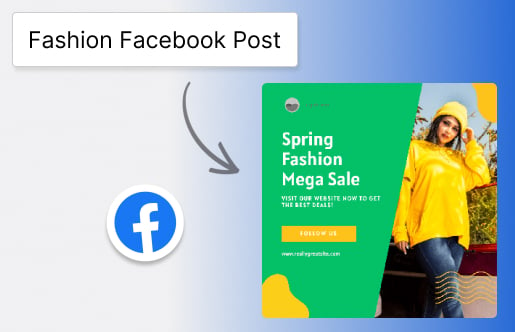
Tips for Brands to Use AR Ads Effectively
- Reach the right people: AR ads should be useful to the people who see them.
- Keep interactions simple and fun: People should be able to connect with you without any problems.
- Use AR filters and try-ons: Great for names in fashion, beauty, and cars.
- Measure engagement metrics: Keep track of the time spent, the number of contacts, and the conversion rates.
Conclusion
Digital marketing has been revolutionized by Facebook’s augmented reality advertisements, which have increased engagement, conversions, and brand recall. Several companies, like Sephora, Ray-Ban, IKEA, and Coca-Cola, have effectively utilized augmented reality (AR) to create immersive shopping experiences for their customers. Augmented reality (AR) ads are a sensible step for the future if you are wanting to improve your digital marketing strategy.
Do you wish to initiate a campaign for augmented reality advertising? You may immediately improve the digital presence of your brand by beginning to play with the augmented reality capabilities offered by Facebook.
